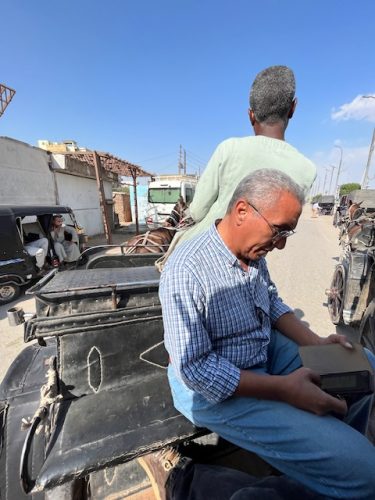On our final full day on Le Fayan, our Nile cruiser we were extremely busy touring sites around Luxor.

Our guide Hani kept us on schedule at every venue.
After breakfast we met our tour guide, who had been traveling on the ship with us, in the lobby of the boat.

The corniche in Luxor.
We three met our local driver on the corniche in Luxor and headed to the mortuary temple of Queen Hatshepsut, who reigned for two-decades in the mid-15th century BCE.

Approaching the mortuary temple of Queen Hatshepsut in a golf cart.
The Temple of Hatshepsut in Deir el-Bahari, called the “Temple of a Million Years”, is a mortuary temple of Queen Hatshepsut, a pharaoh of the 18th dynasty.

Sphynx with Queen Hatshepsut’s face.
A processional alley flanked by sphinxes with heads of Hatshepsut leads to the entrance from the east.

We arrived early in the day with a handful of other tourists.
The temple is dedicated to Amun, god of wind, who came to be identified with the solar god Ra and the god of fertility and creation Min, so that Amun-Ra had the main characteristic of a solar god, creator god, and fertility god.

Like most of the temples and tombs in Egypt this one is monumental.
Built in the 15th century BC following the plans of architect Senenmut, it was mostly hewn in the rock.

Charlie’s taking a close-up photo of the painted scene inside the temple.
The walls of the temple are decorated with scenes from the queen’s life.

Our driver (left) and guide Hani had been waiting for us to tour Hatshepsut.
We met our driver in the parking lot and drove to the Valley of the Kings where pharaohs were buried in hidden caves to protect their bodies and possessions.

Valley of the Kings
At one time this major necropolis just looked like a rocky hillside.

The Book of the Heavens is represented on the ceiling.
We visited the Tomb of Ramses IX (1126– 1108 BC), with a wide entrance, a long sloping corridor, a large antechamber decorated with the animals, serpents and demons from the Book of the Dead – then a pillared hall and short hallway before the burial chamber. Graffiti indicates that the tomb has been open since antiquity. In the chamber just before the staircase to the burial chamber are the cartouche symbols of Ramses IX.

The inside of the tomb was both carved and painted.
Although unfinished it was the last tomb in the valley to have so much of its decoration completed, and the paintings are relatively well preserved. A number of wooden statues of the pharaoh and the gods were salvaged and taken to the British Museum in the 19th century, although the pharaoh’s mummy had already been removed in antiquity and reburied as part of the Deir al-Bahri cache.

We posed at the entrance to Tut’s tomb but did no go inside since all the goodies were in the museum in Cairo.
Once under a pile of rocks and undiscovered for centuries Tut’s tomb is now open to tourists. Charlie and I decided not to enter this one because of the extra entry fee and similarity to other included caves in the area. We had seen the looted treasures when we were in Cairo.

Our guide waited for us in the shade of the café along with other guides.
Every historic venue in Egypt has a café where food, souvenirs, and a bathroom can be had — for a price. The seats in this one in the Valley of the Kings were covered with traditional textiles.

In the noonday heat our cruiser is cool and comfortable.
Back to the ship for lunch. The day is only half over and we’ve done quite a bit.
- Egypt – Preliminary Itinerary
- Egypt – Firming Up the Details
- Egypt — Getting There
- Egypt — Cairo
- Egypt — Giza
- Egypt — A Camel Ride
- Egypt — Aswan
- Egypt — Abu Simbel
- Egypt — Cruising the Nile
- Egypt — Felucca at Sunset
- Egypt — High Dam and Philae Temple
- Egypt — Kom Ombo
- Egypt — Edfu Temple
Jo